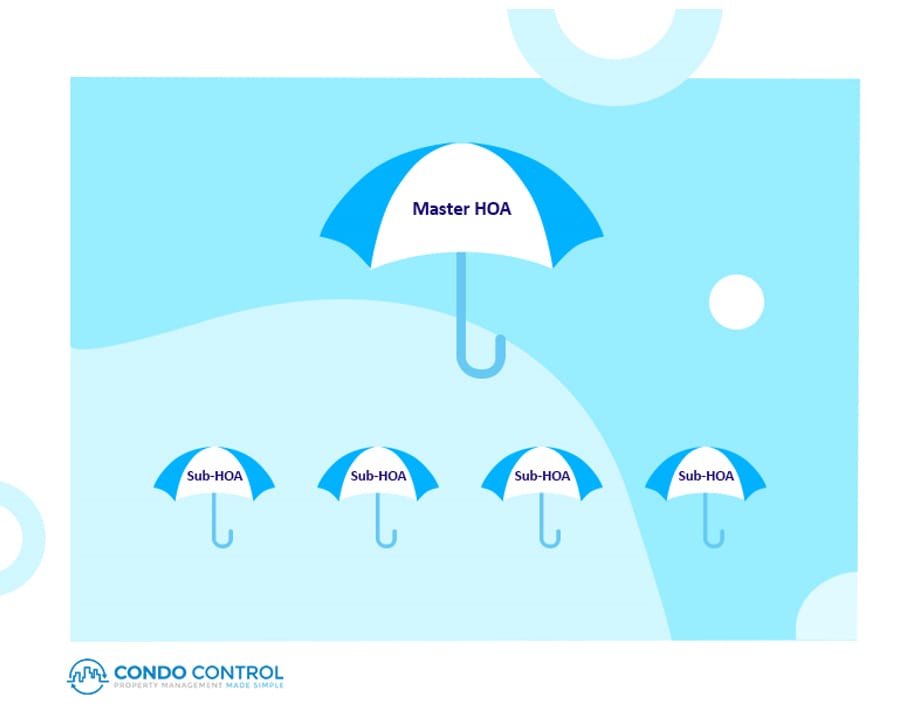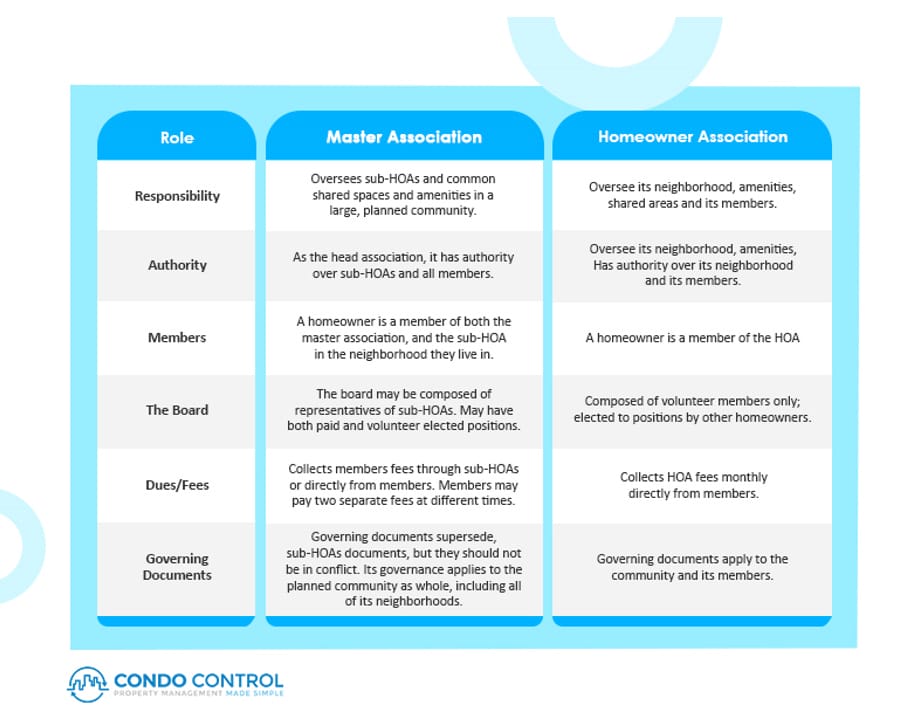Many are familiar with the term homeowners’ association (HOA). HOAs started multiplying quickly in the 1960s as the Federal government encouraged large residential housing developments.
Today, over 74 million Americans live HOAs, condominium communities, or cooperatives.
Table of contents
- What is a homeowner’s association?
- What is a master association?
- Why is a master association necessary?
- How master associations and sub-homeowner associations work together
- Where do member fees go in a master association community?
- Key differences between a master association and homeowners association community
- What is something master associations and HOAs have in common?
- Master associations and HOAs together, but different
So, people may assume that living in a community with a master association or an HOA are the same thing. They would be mistaken. There are important differences that will impact homeowners that they should know about in advance.
Do you know what the differences are?
If not, we’ll start by bringing some clarity and defining each type of association.
What is a homeowner’s association?
Here is a brief overview of the homeowners’ association.
What is it?
A homeowners’ association (HOA) is an organization that oversees and helps to manage the community where it exists.
Who is it?
The HOA is comprised of individuals, referred to as board members, who themselves, own homes in the community.
What does it do?
The role of the HOA is to ensure the community it oversees adheres to community’s governing documents:
- Rules and regulations
- Bylaws
- covenants, conditions, and restrictions (CC&Rs)
- Policies
In doing so, its goal is to maintain a harmonious living environment.
Let’s take a look at master association now.
What is a master association?
A master association may have the same goal but has broader oversight. Here is a brief explanation of a master association.
What is it?
A master association is an organization that oversees a large, planned community as well as other homeowner associations within that community, known as sub-homeowner associations or sub-HOAs. There are multiple neighborhoods within the community and shared common areas and amenities.
Who is it?
Some master associations may be comprised of volunteers from various neighborhoods within the community. You may also find paid individuals in master associations and/or a combination of both.
What does it do?
A master association oversees, maintains, and enforces rules and regulations for the shared common areas and amenities that the multiple neighborhoods in the community use.
Now, you may be wondering why have more than once association. Let’s go further.
Why is a master association necessary?
Sometimes in large, planned communities more than one homeowner association is required to manage the various neighborhoods. The size of these large, planned neighborhoods could consist of thousands of homeowners, so sub-HOAs are established for each neighborhood to better manage each neighborhood.
Additionally, with a structure that has multiple sub-homeowner associations, a hierarchy is needed for decision-making where actions will affect all the neighborhoods within the community. Therefore, a master association is needed and takes on that role.
In its role as the master association, it acts to:
1. Provide consistency
Sub-HOAs can arrive at different decisions that may conflict with each other.
For example, one association may allow members to use the shared pool facility any time day or night, whereas another may have a rule that allows members to use the pool only until 8 p.m.
Some members may end up feeling restricted from common areas that they are equally paying for. In this case, as it’s a shared amenity, the master association will make a final decision about what the rule will be and all sub-HOAs must comply.
So, the master association has the authority to impose overall community standards for common areas and amenities for consistent maintenance and management.
2. Avoid duplication of effort and expenses
The shared grounds in a large, planned community requires a lot of maintenance as well as service providers to maintain the overall look and quality of the community. The upkeep may include flowers, trees, security personnel and shared amenities like tennis courts and a recreation facility.
A master association will coordinate the services for the sub-homeowner associations so that time and funds are allocated efficiently, and sub-homeowner associations aren’t duplicating efforts and paying for services that have already been paid for by other associations.
3. Address disputes
Thousands of residents in a large, planned community means many voices, opinions and unfortunately disagreements. These disagreements can escalate into major conflicts, whether it be among individual homeowners or the sub-HOAs.
A master association is in charge of ensuring the entire community operates in harmony, all the neighborhoods and sub-HOAs, so it is responsible for addressing and relieving conflicts.
The master association is not supposed to take a side, rather it is neutral will arrive at a resolution about the dispute using the master association’s guiding documents.
4. Plan for the future
A single vision for the overall community is important for its visual appearance as well as for the success of a flourishing planned community. Trying to implement many visions from sub-HOAs leads to confusion and a lack of cohesion.
A master association plans for the big picture of all the neighborhoods collectively. It’s like seeing the forest, not just the trees.
In this way, the master association considers large financial projects that will affect everyone.
How master associations and sub-homeowner associations work together
Generally, a sub-homeowner association within a master planned community focuses on the specific needs of its own neighborhood. This could pertain to the type of housing that is in that community.
For example, if the master planned community includes single homes, townhomes and condominiums, then the sub-HOA that oversees the condominiums will look after items related specifically to condominiums, like elevator maintenance, package delivery and elections, etc.
However, the same sub-HOA will defer to the master association for maintenance of the laneways and/or roads the bring traffic through the neighborhood passing by the condominium. So, if there is a pothole in the road in front of the condominium, it is the responsibility of the master association to fix it.

How does the master association know what each sub-HOA needs?
Master Association Meetings
The master association and sub-HOAs learn about what needs to be addressed through regular master association meetings. Regular master association meetings are held monthly and/or quarterly with sub-HOAs and property managers, where items on the agenda may include:
- Financial reporting
- Maintenance for common areas
- Compliance—rules
- Special home-owner issues
In this way matters between and on behalf of sub-HOAs and their master association can be addressed in open communication.
Now that you know how the separate associations work together, you may have guessed that if two associations are working on the homeowner’s behalf, then that means two associations need to collect fees.
Where do member fees go in a master association community?
Again, while the master association and sub-HOAs work together, they are separate. This translates to homeowners paying dues to both associations.
The rate of the dues and the way the dues are collected will be indicated in the planned community’s governing documents .
Dues paid may be structured such that members:
- Pay a single fee to their specific sub-HOA that includes the master association fee.
- Pay two separate fees, one to the sub-HOA and a separate fee to the master association.
Either way, both associations will receive dues from members.
With this in mind, let’s take a closer look at how master associations differ from communities with a sing HOA.
Key differences between a master association and homeowners association community
Here are some differences between a master association and a homeowner association.

At this point you can see that the master association is really in charge of the community as it relates to all the common areas and shared amenities, as well as acting as the final decision-maker when there is conflict that can not be resolved by sub-HOAs.
Whereas a community with a single HOA is responsible for all of these things on its own.
So, why do people choose to live in a master planned community if it seems like there are just more associations to contend with?
Benefits of living in a master planned community:
- These communities have almost all the amenities a homeowner may want or need.
- Located close to healthcare, schools, and shopping.
- Security patrol 24/7. Can be within a gated community.
- Access to many social events and classes
- Mixed-use developments (single family homes, town homes, condominiums, commercial) tend to hold and increase property value.
- Immaculate neighborhoods, highly managed.

These benefits are valuable to many who choose to live in these master planned communities. Of course, managing any HOA community requires excellent property management. So there is something that both master associations and regular HOAs use to achieve this goal.
What is something master associations and HOAs have in common?
As you can see both master associations and HOAs have similar responsibilities, but in different contexts. In large, planned communities, with multiple neighborhoods there are a lot of activities and transactions that transpire.
The activities and transactions are numerous and vary for both master associations and HOAs including :
- Collecting fees
- Incoming and outgoing packages
- Security
- Violations
- Voting
- Caring for the property
- Announcements
- Website development
The list is extensive for HOAs, and volume multiplied exponentially with a master association. Therefore, you will find that both HOAs and master associations implement property management software to keep order, eliminate manual tasks and administrative headaches by streamlining and automating day-to-day processes.
Benefits of HOA management software:
When managing thousands of households, property management software is a must for master associations and HOAs. They both often use software, and excellent property management software is the necessary tool to keep planned master communities running smoothly and in harmony because it can:
- Improve communication through multiple communication channels.
- Keep the fleury of documents organized, safe but quickly accessible.
- Optimize security in a large community, with a lot of ground to cover.
- Streamline violation management.
- Track and manage maintenance requests so nothing is forgotten or stuck.
- Keep orderly visitor parking.
- Simplify the voting process and help HOAs make quorum.
Property management software is a tool that both master associations and regular HOAs lean on to make sure their community is organized and can flourish.
Master associations and HOAs together, but different
You will find HOAs operating on their own, but master associations will always be found in conjunction with sub-HOAs. In other words, for there to be a master association there must be one or more sub-HOAs it oversees.
They work in tandem together to manage the multiple neighborhoods that exist in a master planned community. There are specified differences between each type of association, as noted in the chart above, however the primary difference in their responsibilities is that the master association is responsible for the overall maintenance and care of the community for shared spaces, while is sub-HOAs are responsible for their specific neighborhoods within the community.
Its important for homebuyers to understand the differences as well as how these differences can impact where and how they live in a planned community.
The post Master Association vs HOA: What’s the Difference appeared first on Condo Control.